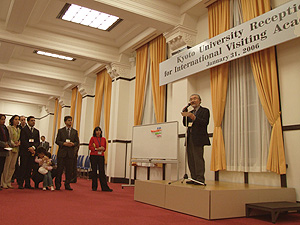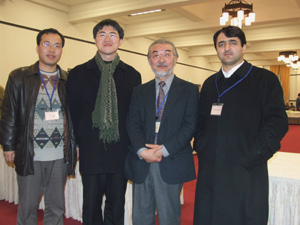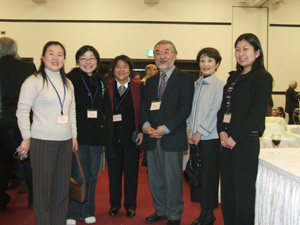Kazuo OIKE
Good evening ladies and gentlemen, I am Kazuo Oike, president of Kyoto University.
I would like to express my deepest appreciation to all of you for attending the party this evening. It is my great pleasure to welcome you all to this international hall in the Centennial Commemoration Clock Tower of Kyoto University.

To maintain this important Clock Tower from earthquake strong motion, we have 80 earthquake-absorbing equipments in the underground of this clock tower. Because we have a big active fault, Hanaori fault about 100m from here to the east. But you are quite safe during you stay in this clock tower. So please enjoy the party this evening.
Our University was established in 1897 as the second oldest national university in Japan, and has the distinguished history of 109 years. We are proud of the level of research and education, and our international friendship with many universities abroad. More than 2500 researchers from abroad are visiting our university annually.
In Kyoto University we have many students and researchers from 100 or more countries and regions. The calendar system of A.D. is not necessarily used all over the world. So the beginning day of a new year is celebrated on a different day in each country.
For example in the case of China, a new year is celebrated by lunar calendar. The day before yesterday was the first day of the lunar calendar this year. The lunar New Year is the greatest vacation for a Chinese for a year. China Railway Bureau announced lunar-New-Year operation this year 40 days from January 14 to February 22.

In Japan, the new year is celebrated to a solar calendar. And the eve of the beginning of spring of the day in front of the first day of spring of a solar calendar is also celebrated on a grand scale.
On February 3rd, a traditional event called “Setsubun” is practiced in Japan. “Setsubun” is the most important festival of spring in Japan.
The whole family will join together and chant, “Oni wa soto, fuku wa uchi.” ("Out with the demons, in with good luck.") , then scatter soy beans about the house to bring good luck.
At Yoshida Shrine east of Kyoto University, Pre-Setsubun rite, in the evening on Feb 2. The most fantastic event is the Karo Festival (at 23:00 on the 3rd) , the fire burns all night. Many stalls open just in front of the main gate of the university and on the mountain during these three days, selling sake, hot food, etc.
Other celebrations of “Setsubun” involve eating “Nori Maki”, a special sushi roll. Particularly in Western Japan, many may face a "lucky direction", and try to eat the entire sushi roll without saying a word. In the case of this year the lucky direction is SSE.

I am going to introduce another local culture which is one of my hobbies, that is Origami, or paper folding using a square paper and making many things. There are many popular folding objects for examples, flowers, balloons, gold fish, frogs, swans, and others. I have prepared today a set of samples to introduce one of the fundamental ways to make four simple examples. I will keep them in the lounge "Kizuna" tomorrow.
Thus, during your stay in Kyoto city and in Kyoto University, I hope you can enjoy many things not only as your study but also much culture in Kyoto city and in Japan.
Thank you.

